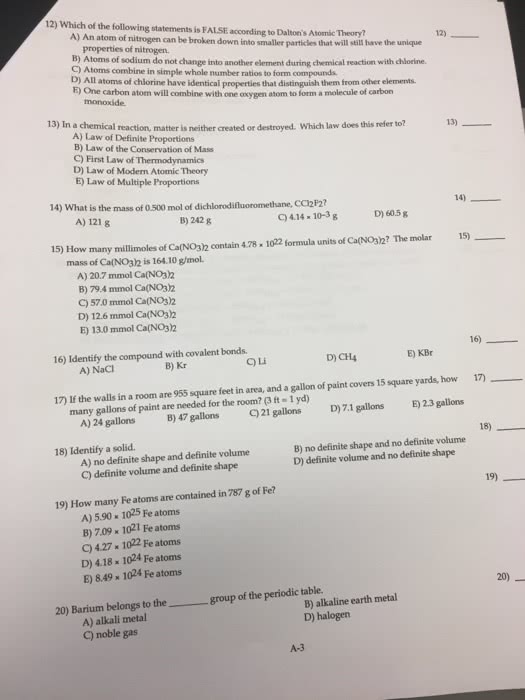1. Which characteristic below describes ONLY a solid (not liquid or gas)?
a) definite shape b) particles in contact c) definite volume d) completely fills container
2. When iron rusts, it forms a reddish-brown solid. This is:
a) a physical change b) a chemical change c) no change at all
3. What is the name of FeSO4?
a) iron (I) sulfate b) iron (II) sulfate c) iron sulfite d) iron sulfide
4. A bottle label states that the bottle contains âdrinking water with minerals added for flavor. This would be an example of:
a) an element b) a compound c) a heterogeneous mixture d) a homogeneous mixture
5. Which answer has the correct number of significant figures for: length = 2.0 m + 0.2100 m?
a) 2.2 b) 2.21 c) 2.210 d) 2.2100
Place the answer with the correct number of significant figures on the lines provided below.
6. To drive one kilometer, how many centimeters should you drive?
_______________cm
7. A 10.0 gram block of gold has a density of 19.32 g/cm3. What is its volume?
______________cm3
8. What is the formula of sodium sulfide?
_________________________
9. What is the name of H2S?
_______________mm
10. How many neutrons are in 35Cl?
_______________ neutrons
For problems 11 through 13, show your work to receive full credit and use the correct number of significant figures in your final answer.
11. The density of nickel is 8.91 g/cm3. Calculate the mass of a nickel ball with a radius of 0.50 mm in grams.
(Ï = 3.1416; Vsphere = 4Ïr3/3)
12. The recommended adult dose of Elixophyllin , a drug used to treat asthma, is 6.00 mg/kg of body mass. Calculate the dose in milligrams for a 134-lb person.
13. It is 273 K outside. Do you need a jacket? Why or why not? (show your work for full credit)
14) Element X has three naturally occurring isotopes. The masses (amu) and % abundances of the isotopes are given in the table below. What is the average atomic mass of the element in amu?
1. Which characteristic below describes ONLY a solid (not liquid or gas)?
a) definite shape b) particles in contact c) definite volume d) completely fills container
2. When iron rusts, it forms a reddish-brown solid. This is:
a) a physical change b) a chemical change c) no change at all
3. What is the name of FeSO4?
a) iron (I) sulfate b) iron (II) sulfate c) iron sulfite d) iron sulfide
4. A bottle label states that the bottle contains âdrinking water with minerals added for flavor. This would be an example of:
a) an element b) a compound c) a heterogeneous mixture d) a homogeneous mixture
5. Which answer has the correct number of significant figures for: length = 2.0 m + 0.2100 m?
a) 2.2 b) 2.21 c) 2.210 d) 2.2100
Place the answer with the correct number of significant figures on the lines provided below.
6. To drive one kilometer, how many centimeters should you drive?
_______________cm
7. A 10.0 gram block of gold has a density of 19.32 g/cm3. What is its volume?
______________cm3
8. What is the formula of sodium sulfide?
_________________________
9. What is the name of H2S?
_______________mm
10. How many neutrons are in 35Cl?
_______________ neutrons
For problems 11 through 13, show your work to receive full credit and use the correct number of significant figures in your final answer.
11. The density of nickel is 8.91 g/cm3. Calculate the mass of a nickel ball with a radius of 0.50 mm in grams.
(Ï = 3.1416; Vsphere = 4Ïr3/3)
12. The recommended adult dose of Elixophyllin , a drug used to treat asthma, is 6.00 mg/kg of body mass. Calculate the dose in milligrams for a 134-lb person.
13. It is 273 K outside. Do you need a jacket? Why or why not? (show your work for full credit)
14) Element X has three naturally occurring isotopes. The masses (amu) and % abundances of the isotopes are given in the table below. What is the average atomic mass of the element in amu?
isotope38 abundance of 5.07,mass of 37.919
isotope39x,abundance of 15.35,mass of 39.017
isotope 42,abundance of 79.85,mass of 42.111
15. Classify each of the following elements as alkali, alkaline earth, halogen or a noble gas:
a) He ________________________
b) F ________________________
c) Na ________________________
d) Ca ________________________
e) Br ________________________


